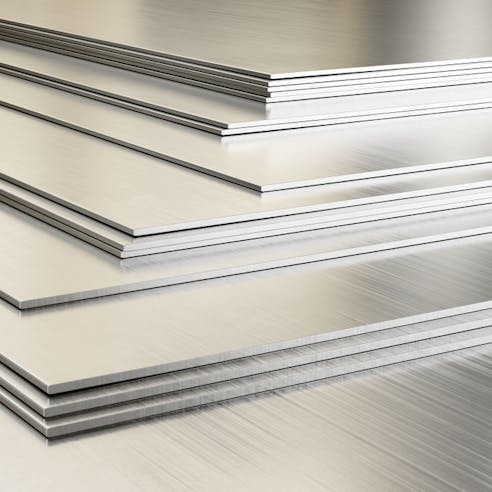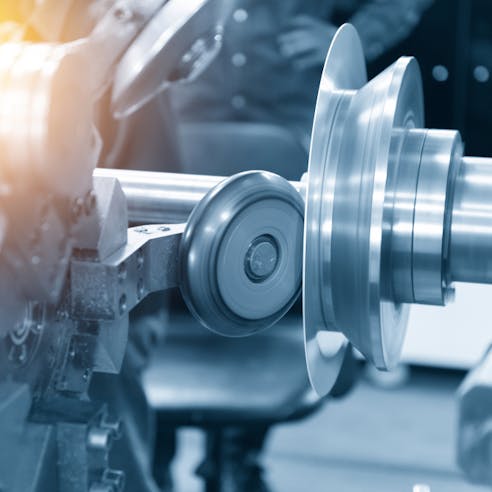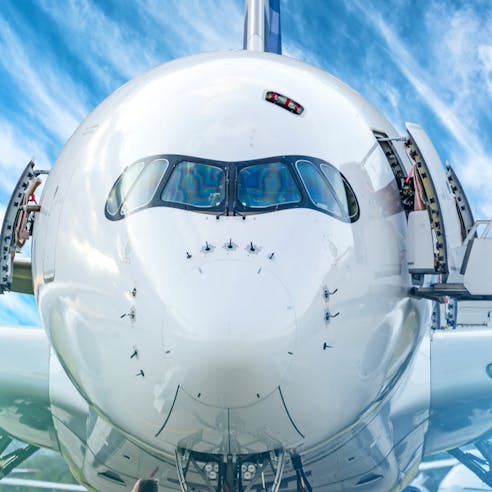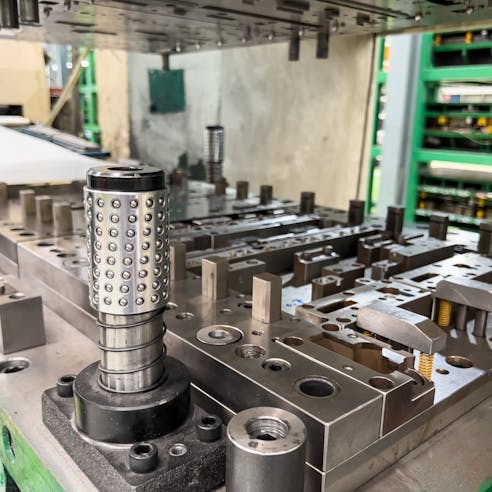Metal Spinning Services by Xometry
Xometry offers the highest quality metal spinning services and can assist in the production of parts with intricate and complex geometries and excellent surface finishes. Subject to availability. Xometry doesn't guarantee that we can provide this service at any given time.
Metal spinning is the process of forming a flat sheet of material into an axially symmetric part. Common materials used for fabricating spun parts include: aluminum, carbon steel, brass, and titanium. Advanced superalloys, including some Inconel® and Hastelloy® grades, can also be spun. Metal spinning is low-cost, produces seamless parts, and can work on a wide range of metals. Typical applications can include: cookware, pressure vessels, and rocket engine components.
Xometry offers the highest quality metal spinning services available in the market today. Keep reading and learn more about how expertly executed and carefully controlled metal spinning can benefit your project.
What Is Metal Spinning?
Metal spinning is the process of forming a circular sheet of metal into an axially symmetric final product. It is typically performed on a lathe by clamping the metal plate to one end of a pattern (or mandrel), then spinning the plate while applying tools against the metal to gradually form it around the pattern.
The first step in metal spinning is to make a pattern or form. Forms are usually machined from either metal or hardwood. The form is fixed to the headstock of the lathe. A flat metal blank is then securely clamped to the form with a pressure pad, which is mounted to the tailstock.
During the actual forming process, the metal blank is spun at high speed, and a set of tools progressively applies pressure to the plate to incrementally form it around the pattern. The many different available types of shaping tools are each designed to create particular features in the part. The spinning process may either be manual or automated with CNC equipment, making it suitable for either low or high-volume production.
Types of Metals for Metal Spinning
A wide range of metals can be processed via spinning. Listed below are some of the more common metals used, their typical applications, and the challenges involved with each one:
- Stainless Steel
- Carbon Steel
- Galvanized Steel
- Aluminum
- Copper
- Inconel®
- Hastelloy®
- Titanium
- Bronze
- Brass

Stainless Steel
Stainless steel is a popular material choice for applications that require corrosion and temperature resistance, and metal spinning is a good choice for making large, deep vessels with no seams. It is ideal for cookware and healthcare applications. Stainless steel can work harden, which can make it challenging to form. It must however be noted that some forms of stainless steel, like austenitic steel, are more prone to work hardening when compared to ferritic steel. This can be alleviated with periodic annealing during the spinning process.
Carbon Steel
Carbon steel is a cheap and easy-to-form material. It exhibits work hardening in varying degrees, depending on the carbon level. However, any additional alloying elements present, along with the kind of previous heat treatment applied, will also affect the workability of carbon steel. Both hot-rolled and cold-rolled steel can be spun, with hot-rolled steel being the easier choice. Carbon steel can easily be painted if improved corrosion resistance is required.
Galvanized Steel
Galvanized steel refers to carbon steel that has been coated with zinc by dipping the metal into a bath of molten zinc. This coating improves corrosion resistance by behaving as a sacrificial anode, thereby protecting the base material. Using galvanized steel means that no post-spinning corrosion protection is required as the spinning process does not generally damage the zinc coating, provided the part is not cut after spinning.
Aluminum
Aluminum is a popular material for spinning due to its formability, corrosion resistance, and high strength-to-weight ratio. Unalloyed aluminum is the easiest to form but lacks mechanical strength. Alloyed grades are therefore preferred for most applications. Aluminum metal spinning can be a low-cost alternative to stainless steel while also being less prone to work hardening, making it easier to work with.
Copper
Copper is ideal for metal spinning due to its high formability and is resistant to cracking or tearing during forming. It is electrically and thermally conductive while also having antimicrobial properties that make it suitable for medical use. Copper is not suitable for applications where mechanical strength is desired. In these cases, bronze or brass might be better suited.
Inconel®
Inconel® is a superalloy that maintains its mechanical strength and oxidation resistance at very high temperatures. Inconel® is heavily affected by work-hardening and must be constantly heated by a flame torch to make it malleable enough to form. Inconel® is primarily used in demanding aerospace applications with Inconel® 625 being a commonly used alloy. More advanced techniques make use of a laser to create a localized point of heat instead of heating the entire part.
Hastelloy®
Hastelloy® is another superalloy that has excellent corrosion resistance in high-stress applications. Hastelloy® can be formed but suffers from the same pronounced work-hardening tendencies as other superalloys and stainless steels, and may need to be annealed multiple times throughout the forming process. Commonly spun grades of Hastelloy® include C276 and Hastelloy X.
Titanium
Titanium is lightweight, has excellent corrosion resistance, and excellent strength-to-weight ratio. These properties make it a popular material for aerospace applications where lightweight components help reduce fuel consumption. Titanium can be challenging to form as it may need to be heated to facilitate forming during spinning, which is typically done with a blow torch.
Bronze
Bronze has two main alloying elements, namely copper and tin. It is more difficult to form than copper or brass as it is tougher. However, it has improved mechanical properties such as tensile strength for example, while retaining some of the benefits of copper such as good thermal conductivity. Bronze has improved corrosion resistance when compared to copper. Bronze can be easily spun and is a good alternative to copper if higher strength and toughness are required.
Brass
Brass has two main alloying elements, namely copper and zinc. Brass has good corrosion and biofouling resistance due primarily to its copper content. It also has good formability making it easy to spin. Brass is a visually appealing material and, as such, is often used for decorative purposes such as light shades.
Advantages of Metal Spinning
Metal spinning has a number of advantages when compared to other metal-forming techniques, some of which are listed below:
- Low Costs
- Shorter Cycle Times
- Maximum Design Flexibility for Axisymmetric Parts
- Seamless, High-Quality Construction

Low Costs
Metal spinning can be a relatively low-cost manufacturing method due to its high speed and low material costs due to limited wastage. Costs can be further reduced by making use of automated systems that use specialized CNC spinning machines to produce the part as well as robotic arms that load/unload the machine and post-process the part, for example, by placing the workpiece in a jig for trimming. The forming mandrel can be made from relatively inexpensive materials, further reducing costs.
Shorter Cycle Times
Metal spinning is especially useful if a quick turnaround time is required, for example, for prototypes or one-off parts. Automated systems can also be used to ensure no time is wasted between operations, resulting in maximum productivity and short lead times.
Maximum Design Flexibility for Axisymmetric Parts
Metal spinning can be used to make relatively complex axially symmetric parts that would not be possible using other techniques like stamping or drawing. Multi-part specialized mandrels can also be used to create parts with captive geometry, i.e. ones for which a normal mandrel would not be able to be pulled out of the part once the metal has been formed around it.
Seamless, High-Quality Construction
Metal spinning is ideal for creating containers without any potential weak points produced by fastening methods such as welding or brazing. This makes it ideal for cookware and pressure vessels.
In need of metal spinning services?
Disadvantages of Metal Spinning
Metal spinning can be an excellent solution for creating axisymmetric parts. However, the process does have some disadvantages, as listed below:
Snarl
Snarl refers to imperfections on the spun part, such as wrinkles and folds produced by the material folding back onto itself. These defects can occur due to poor technique, improper lubrication, excessive force applied near the edges, or incorrect tooling. However, these kinds of problems are generally the result of poor design and the manufacturing issues produced by poor design.
Consistency
Achieving consistency between spun parts can be difficult, especially if the parts are produced manually. The operator cannot apply the same pressure each time, and may not follow the exact same forming steps. However, this can be overcome with a CNC metal spinning machine.
Ovality
Making parts with high circularity is often challenging with metal spinning. This is due to a number of factors such as material springback and inconsistent application of pressure. Many of these problems can be overcome with the use of CNC spinning machines that are able to apply pressure at multiple points. However, there will always be a degree of ovality in spun parts.
Long Processing Times
Some parts require multiple passes to be completely formed. Forming the final part in one pass is often not possible, as it may result in the metal cracking. Multiple passes can increase the processing time. This is in contrast to other techniques like metal stamping or drawing, which are significantly faster. Even if the part is formed in a single pass, it can still take longer than other techniques like stamping.
Safety Risks
Metal spinning, especially manual metal spinning, can be dangerous to the operator, who must remain in close proximity to the metal parts spinning at high speed, in order to physically form the metal using hand tools. Specialized CNC spinning machines eliminate much of the risk involved, but it may be difficult to justify the cost of a purpose-built CNC spinning machine.
Metal Spinning Applications
Listed below are some examples of the various industries where metal spinning can be used:
- Aircraft Components
- Food Service Equipment
- Architectural and Lighting
- Cookware
- Gas Cylinders and Pressure Vessels
- Heavy Industrial Components
- Musical Instruments
- Aerospace
- Stationary Power Generation

Aircraft Components
Aircraft components such as nose cones, cowls, and structural body components are ideally suited to metal spinning. Aluminum and titanium are popular material choices due to their excellent strength-to-weight ratios.
Food Service Equipment
Large mixing bowls and cooking utensils (i.e. a soup ladle) are examples of food service equipment that can be produced by metal spinning. Stainless steel is often the material of choice.
Architectural and Lighting
Metal spinning is a popular choice for producing architectural and lighting components. For example, bronze is often spun to form decorative light fixtures. Similarly complex geometrical shapes are spun for use as decorative panels and other features in architectural applications, for example, to enhance the exterior of a building.
Cookware
Cookware, including such things as pots, woks, and pans, is often produced by metal spinning. Stainless steel is the most popular material for these types of applications due to its corrosion resistance. Spinning creates a seamless part, meaning that there are no weak points in the cookware that could fail or corrode.
Gas Cylinders and Pressure Vessels
Metal spinning can reduce the number of welds required for a pressure vessel. For example, a single circumferential weld can be used to join two halves of the vessel instead of two circumferential welds plus a longitudinal weld, which is generally weaker than a circumferential weld. Minimizing the number of seams improves the structural integrity of the pressure vessel. Typical applications can include gas canisters and fire extinguishers.
Heavy Industrial Components
Metal spinning can be used to produce fuel tanks, pressure vessel dished ends, exhaust systems, and heavy-duty wheel rims. Carbon steel is a popular choice for automotive applications, whereas stainless steel is better suited for applications in more corrosive environments.
Musical Instruments
Metal spinning is used to produce musical instruments like trumpets and cymbals, for example, from brass and bronze. No other technique is effective and cost-efficient for long cylindrical tubes common for wind instruments.
Aerospace
Metal spinning can be used for a wide range of applications in the aerospace industry, such as: nose cones for aircraft and rockets, rocket engines, and satellite dishes. Almost all of the abovementioned materials like Inconel, Hastelloy, titanium, and aluminum for example are used for aerospace applications.
Ground Power Turbine Generation
Stationary power-generating turbines can benefit from metal-spun parts. They can be used for exhausts for spent combustion products, or casings for thermal insulation. High-temperature, corrosion-resistant materials in the Inconel or Hastelloy groups are ideal for these types of applications.
Alternatives to Metal Spinning Services
Metal spinning is a relatively niche manufacturing technology that is typically only used for axisymmetric components. In some cases, alternative technologies, such as stamping, might be better suited for a given design. Xometry’s metal stamping service is ideal for high-volume production of relatively simple sheet metal parts. One potential disadvantage is that stamping requires expensive tooling and can have long initial lead times because of that.

Why Choose Xometry for Metal Spinning Services?

Endless Options
Choose from millions of possible combinations of materials, finishes, tolerances, markings, and certifications for your order.

Easy to Use
Get started with our easy-to-use platform and let our experts take care of managing the project from locating the right manufacturing partner to delivery logistics.

Vetted Network
We are ISO 9001:2015, ISO 13485, and AS9100D certified. Only the top shops that apply to become Suppliers make it through our qualification process.